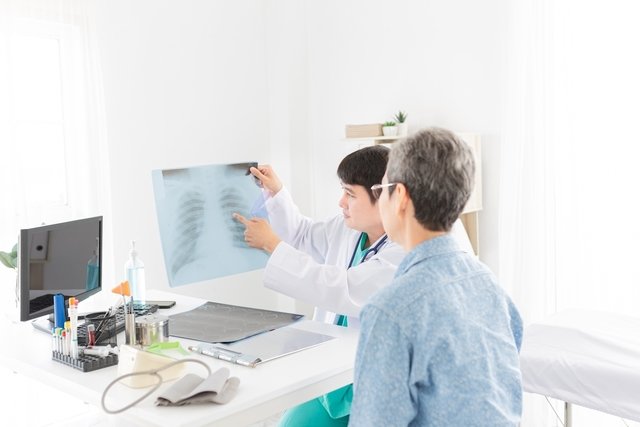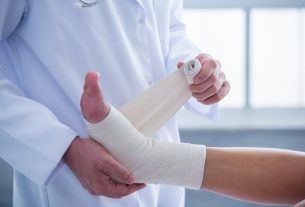A broken rib is the total or partial rupture or crack of one or more ribs, caused mainly by trauma, resulting in symptoms such as intense pain that worsens with breathing or when trying to twist the trunk, difficulty breathing, swelling or bruising at the site.
The ribs are present in the rib cage and their function is to protect the thoracic organs, such as lungs, heart, kidneys, thymus, trachea and esophagus, for example, in addition to helping with breathing and, when a fracture occurs, it can cause injuries to internal organs.
Broken rib treatment is carried out by an orthopedist who may recommend the use of analgesics to relieve pain, as well as rest and physiotherapy. Surgery is only indicated in some cases, where there is no improvement with initial treatment, or when the fracture causes serious injuries, including perforation of the lungs or other organs in the chest.

Broken Rib Symptoms
The main symptoms of broken ribs are:
- Severe pain in the chest, which worsens with breathing, coughing or when trying to twist the torso;
- Difficulty breathing;
- Bruising or swelling in the chest;
- Deformity in the costal arches;
- Pain or noises during palpation of the chest.
A rib fracture that does not have separate bones or an irregular edge is simpler to resolve and does not pose any major health risks. See more about the symptoms of a rib fracture.
However, the fracture is considered serious when it has an irregular edge or the bones are separated, as it can cause perforation of the lungs, called pneumothorax, and other organs and blood vessels in the chest. Know how to identify the symptoms of pneumothorax.
Therefore, when symptoms such as difficulty breathing deeply, pressure or pain in the chest, coughing up phlegm or blood, or fever appear, you should go to the hospital immediately to begin the most appropriate treatment quickly, as they can put your life in danger. risk.
How to confirm the diagnosis
The diagnosis of broken ribs is made by a general practitioner or orthopedist through evaluation of symptoms, history of accidents or blows, health history and physical examination.
Make an appointment with an orthopedist in the nearest region:
Taking care of your health has never been easier!
To confirm the diagnosis, the doctor must order imaging tests, such as chest X-ray, computed tomography, magnetic resonance imaging, ultrasound or bone scintigraphy, as they allow identifying the number of ribs affected, side, region and severity of the fracture, as well as injuries in blood vessels, nerves or chest organs.
Furthermore, these tests allow the doctor to evaluate complications such as bleeding (hemothorax), air leakage from the lung to the chest (pneumothorax), pulmonary contusion or injuries to the aorta, for example.
Possible causes
The main causes of broken ribs are:
- Accidents with cars, motorcycles or bicycles;
- Falls or blows to the chest;
- Osteoporosis;
- Attacks on the chest or trauma by penetrating objects;
- Practice contact sports, such as football, judo, jiu-jitsu, karate, hockey or basketball;
- Intense cough
- Carrying out work with repetitive chest movements;
- Tumor or metastasis in the bones.
Fractures are more common in young people, but can also happen in the elderly due to falls.
In babies or children, ribs are more elastic than in adults, making rib fractures less common. Therefore, when a child has a broken rib, it may indicate abuse, such as repeated pushing or direct trauma to the chest.
How the treatment is carried out
Broken rib treatment must be carried out under the guidance of an orthopedist, and varies according to the severity of the fracture and the number of ribs affected.
Generally, for simple fractures in just one rib, rest, application of ice to the area and use of analgesic medications, such as paracetamol or ibuprofen, are recommended to relieve pain. In some cases, an intercostal nerve block may be performed to help control pain.
It is not recommended to tie anything around the chest because it can make it difficult for the lungs to expand, causing further complications, such as pneumonia, for example.
In cases where there is no improvement in symptoms or in cases of severe rib fractures, in which there is intense bleeding or involvement of organs in the rib cage, treatment is usually performed with surgery.
Physiotherapy is also very important, as exercises are recommended that help maintain muscle strength and range of the chest joints, as well as breathing exercises that help find better ways to expand the chest.
Daily care
During fracture recovery it is recommended:
- Do not sleep on your side or on your stomach. The ideal position is to sleep on your back and place a pillow under your knees and another over your head;
- Do not drive in the first few weeks after the fracture, nor twist the trunk;
- Hold a pillow or blanket against your chest if you want to cough to help reduce the pain when coughing;
- Sit in a chair, leaning your torso forward to breathe better, if you feel pain in your chest;
- Do not practice sports or physical activities until authorized by your doctor;
- Avoid staying in the same position for a long time (except while sleeping);
- Avoid lifting weights, doing push-ups, pushing or pulling objects;
- Avoid drinking alcohol and smoking to help the rib heal faster.
In addition, you should do breathing exercises guided by your doctor every 2 hours, such as slow, deep breathing, and coughing gently into a pillow, to avoid infections or lung collapse. Check out other tips on how to recover from a fracture faster.
Recovery time
Most broken ribs heal within 1 to 2 months, and during this period it is very important to control the pain so that you can breathe deeply, avoiding complications that may arise due to this difficulty in breathing normally.

Sign up for our newsletter and stay up to date with exclusive news
that can transform your routine!
Warning: Undefined array key "title" in /home/storelat/public_html/wp-content/plugins/link-whisper-premium/templates/frontend/related-posts.php on line 12
Warning: Undefined array key "title_tag" in /home/storelat/public_html/wp-content/plugins/link-whisper-premium/templates/frontend/related-posts.php on line 13



